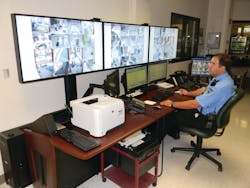The Economics of Ergonomics
Most security personnel confined to control centers and central monitoring stations have experienced it — and you probably have as well: As you are packing up to head home at the end of a long work day, your body aches and you feel exhausted. Most people chalk it up to a busy day at work and hope they will feel better the next day, but the cycle often continues day after day. Something else must be wrong. The bottom line is that these physiological issues can have a dire effect on the productivity and health of security personnel, which can be detrimental to both overall security and business operations.
While security monitoring personnel may be working hard and putting in long hours, their aches, pains and general fatigue may actually be the result of the technical furniture installed in their central monitoring environment. Without proper ergonomics, security personnel can experience back and neck pain, causing them to slouch — which can lead to a host of chronic ailments, including arthritis and bursitis, as well as musculoskeletal disorders, obesity, diabetes and more. In addition, it is extremely fatiguing for one’s body to compensate for improper positioning and/or lack of movement during the course of the day, which can lead to further complications.
It stands to reason that if poorly designed furniture is detrimental to one’s health, then well-designed furniture can have positive impacts. The Washington State Department of Labor reviewed 250 ergonomics case studies and found that properly designed furniture systems provide numerous business benefits, including higher productivity, increased employee engagement, and a better overall health and safety culture within the workplace. All this readily applies to technical furniture systems for use in central monitoring stations and all security control centers.
Designing for Health
When planning and designing a security monitoring environment, it is important to consider the posture and neck angle of the system operators who will be spending hours on end viewing video displays. Design software like Middle Atlantic Products’ Designer with its ergonomic line of sight tool (available free on the MAP website), can help ensure correct positioning of monitors on workstations and on large video walls. It is also sensible to select furniture that allows multiple displays to be easily adjusted to accommodate an individual’s changing position. This is particularly important in security control rooms where different employees using the same workspace can adjust the video displays to optimum viewing angles. Slide-out keyboard trays, ergonomically suitable chairs and the radius of “frequently used” items all play a part in operator comfort and correct ergonomics, based on operator size and his or her interaction with the system.
The employee wellness that results from having an ergonomic and comfortable control center furniture system has a number of additional benefits. Because the risks of short- and long-term health problems are lower, medical and other related costs are potentially reduced. According to U.S. Bureau of Labor Statistics studies, approximately $1 of every $3 in worker’s compensation costs can be attributed to various musculoskeletal diseases that result from poor ergonomics. Properly designed technical furniture systems can help reduce an employer’s potential liability for on-the-job injuries such as disc alignment and carpal tunnel syndrome.
For security professionals whose jobs require them to sit at a desk or console most of the day, there is an even greater potential problem from what medical experts have dubbed “Sitting Disease.” To study the effects of sitting for long periods, the American Cancer Society tracked more than 120,000 individuals from 1993 to 2006 and found that sitting more than six hours a day — at home, work and while commuting — can increase mortality rates. These statistics take on even more significance when you consider that the average American sits for 7.7 hours per day, or 55 percent of their waking hours, according to a Vanderbilt University study. This is a major issue for all chair-bound workers in the labor force.
While stand-up desks exist, standing all day can be hard on your back and legs. Using a fixed standing desk can also feel awkward, and doesn’t address the overall issue of remaining in the same position for hours at a time. Research has shown that frequent position changes promote better circulation, reduce muscle pain, lower fatigue and help prevent work-related repetitive-stress injuries. With that in mind, the best, most ergonomic solution is an adjustable height workstation, such as Middle Atlantic’s ViewPoint Sit/Stand desk. The innovative adjustable workstation easily raises and lowers the height of the desk surface, allowing personnel to work comfortably in a variety of positions throughout the day while reaping all the documented health benefits.
Improved Awareness and Performance
The improvements that come from well-designed furniture systems are especially important in the professional security industry. When employees in central monitoring stations or control rooms become fatigued, lack of operator attentiveness can be the cause of potentially life-threatening consequences. It makes perfect sense that the benefits derived from ergonomic technical furniture systems can effectively improve employee performance and security operations.
Without chronic pain and fatigue, security personnel will experience less physical stress, heightening their sensory awareness and making them more attentive. The increased situational awareness also enables them to better handle incidents, whether the event at hand is an emergency or not. In general, personnel will be able to do their jobs better. When people feel good, they are generally more productive and more confident, and that confidence translates into better on the job performance.
The issue of ergonomically designed technical furniture for security environments opens up a whole different discussion for professional security integrators and resellers. The combination of employee wellness and heightened security that results from using well designed ergonomic technical furniture can (and should) factor into the way central monitoring stations and control centers are designed.
Educating yourself and your customers who are running a central monitoring operation about the numerous benefits of ergonomic technical furniture — and the risks of poorly designed furniture — is relatively easy given the broad range of research and documentation available on the subject.
Beyond your own central monitoring facility, by demonstrating the benefits and flexibility of ergonomically designed technical furniture systems to your customers, you can help them to increase productivity and security while improving the overall health and satisfaction of their personnel. Plus the ability to integrate ergonomically designed technical furniture systems into your sales proposition can lead to increased revenue.
Dean Wheelan is an Application Engineer for Middle Atlantic Products. To request more information about the company, please visit www.securityinfowatch.com/10215070.



